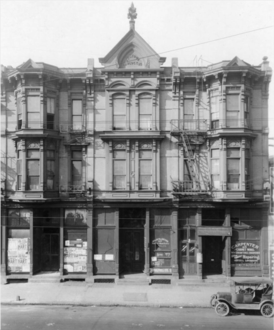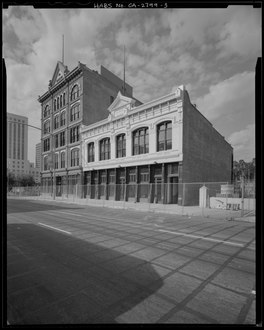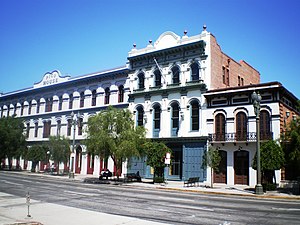Gallery (west side) edit
-
Sentous Block a.k.a Sentous Building, 1920
Gallery (east side) edit
-
Pico House in 1875
-
Pico House and the Plaza in 1876, photo taken from Fort Moore
-
Pico House today
-
Pico House, Merced Theater and Masonic Hall
Pico House edit
Pico House was a luxury hotel built in 1870 by Pío Pico, a successful businessman who was the last Mexican Governor of Alta California. With indoor plumbing, gas-lit chandeliers, a grand double staircase, lace curtains, and a French restaurant, the Italianate three-story, 33-room hotel was the most elegant hotel in Southern California. It had a total of nearly eighty rooms. The Pico House is listed as a California Historical Landmark (No. 159).
Masonic Hall edit
Masonic Hall at 416 N. Main St., was built in 1858 as Lodge 42 of the Free and Accepted Masons. The building was a painted brick structure with a symbolic "Masonic eye" below the parapet. In 1868, the Masons moved to larger quarters further south. Afterward, the building was used for many purposes, including a pawn shop and boarding house. It is the oldest building in Los Angeles south of the Plaza.
Merced Theater edit
The Merced Theater, completed in 1870, was built in an Italianate style and operated as a live theatre from 1871 to 1876. When the Woods Opera House opened nearby in 1876, the Merced ceased being the city's leading theatre.[1] Eventually, it gained an "unenviable reputation" because of "the disreputable dances staged there, and was finally closed by the authorities."[2]
Plaza House edit
This two-story building at 507–511 N. Main St. houses part of the LA Plaza de Cultura y Artes, which includes the Vickrey -Brunswig Building next door.[3] It is inscribed on its upper floor, and on 1890s maps it is marked, "Garnier Block" (not to be confused with the Garnier Block/Building on Los Angeles Street, one block away). Commissioned in 1883 by Philippe Garnier, once housed the "La Esperanza" bakery.[4]
Vickrey-Brunswig Building edit
This five-story brick building facing the Plaza at 501 N. Main St. houses LA Plaza de Cultura y Artes, which also occupies the Plaza House next door. It was built in 1888 and combines Italianate and Victorian architecture; the architect was Robert Brown Young.[5]
Site of Sentous Building edit
The Sentous Block or Sentous Building (19th c., demolished late 1950s) was located at 615-9 N Main St., with a back entrance on 616-620 North Spring St. (previously called Upper Main St., then San Fernando St.). Designed in 1886 by Burgess J. Reeve. Louis Sentous was a French pioneer in the early days of Los Angeles.[6] The San Fernando Theatre was located here. The site is now part of the El Pueblo parking lot.[7][8] <ref>
- ^ Lois Ann Woodward (1936). "Merced Theater" (PDF). State of California, Department of Natural Resources.
- ^ Rose L. Ellerbe (1925-10-25). "City's Progress Threatens Ancient Landmarks: Structures Once City's Pride Now Hidden in Squalor". Los Angeles Times.
- ^ "Plaza House", Library of Congress
- ^ "Plaza House", Water and Power Associates
- ^ "LA Plaza de Cultura y Artes, Vickrey-Brunswig Building", Los Angeles Conservancy
- ^ Louis Sentous biography, Bridge to the Pyrenees
- ^ "San Fernando Theatre", Los Angeles Theatres
- ^ plate 003 of the 1910 Baist Real Estate Survey







